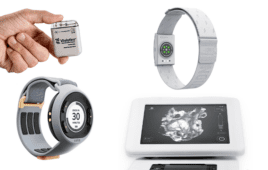A contract manufacturer servicing original equipment
manufacturers in the endoscopy/arthroscopy, orthopedic, dental/orthodontic and
vascular markets has been making significant inroads into selling machined
components for medical blade applications over the last several years. This is
partly because of its customers’ increased use of Custom 465 stainless,
produced by Carpenter Technology Corp.
 |
|
Carpenter Technology Corporation manufactures a |
Custom 465 stainless is a premium quality, high strength,
martensitic, age-hardenable stainless alloy designed for improved notch tensile
strength, fracture toughness and fabricability. Anthony Guitterez, Carpenter’s
medical marketing manager, says that the alloy has been used increasingly for
medical blades, especially in endoscopy/arthroscopy and orthopedic
applications, because of its unique combination of strength, toughness and
fatigue.
Guitterez says that Carpenter continually sees increased
applications for Custom 465 stainless, including for medical blades because of
these properties. “Custom 465 stainless can be used in a variety of instrument
applications, such as for torque drivers, minimally invasive instruments and
various hand-held tools where traditional alloys such as Custom 630 and Custom
455 stainless may not always be an optimal choice for these applications when
high strength combined with excellent ductility is required. Custom 465 also
offers an improvement in corrosion resistance over traditional martensitic
stainless steels such as 410 and 420 stainless materials.”
Increased popularity of Custom 465 stainless has also opened
the door to new business for a number of medical contract manufacturers,
including San Diego-based Veridiam – a leading machining and custom metal
fabrication company. Veridiam services manufacturers in the dental, nuclear
power, aerospace and power generation markets as well as medical OEMs.
The Veridiam Medical Group has seen about a 15% a year
increase in the use of Custom 465 stainless in thin wall seamless tubing and
cannulated bar forms for its medical OEM customers, says Steve Thornton, vice
president of medical sales. This, he says, has helped the company to
substantially increase its medical business, which it has grown to about 40% of
its overall business, up from about 8% just five years ago.
To date, Veridiam Medical has mainly been seeing Custom 465
stainless used by its endoscopic/arthroscopic and orthopedic OEM customers. However,
Thornton says
that the company is starting to see increased calls for the stainless alloy for
use in dental drills as well. Custom 465 stainless could be a good choice for
dental applications because of its high strength, good ductility, improved
toughness and excellent fatigue resistance.
Overall, Thornton
says he expects to see Veridiam Medical’s medical OEM customers double their
usage of Custom 465 stainless over the next three years.
Thornton
says in endoscopy/arthroscopy, where surgeons perform minimally invasive surgery
through a tube, use of thin wall Custom 465 seamless tubing is still not very
widespread. However, he has seen growth in its use for applications where edge
sharpness, edge retention and material strength are critical.
He notes that while Type 420 and Type 400 stainless steels
are considered to be good alternatives for such applications, those alloys
cannot be drawn in tubular forms. Some OEMs do use these alloys, machine a
sharpened tip that could then be welded to a Type 304 stainless tube. The problem
with this, however, is that there could be certain concentricity challenges as
well as additional welding cost and handling issues.
“An elegant solution – and one that is typically less
expensive – is to use a one-piece tube out of Custom 465 stainless,” Thornton says. And
several major OEMs have begun to take advantage of this alloy, which, he says,
also helps surgeons “to push the envelope” of minimally invasive techniques
given that this alloy has about double the strength of Type 304 stainless.
He says that over the last three to four years one of the
world’s largest medical OEMs has taken advantage of the edge sharpness and edge
retention properties of Custom 465 stainless for its hysteroscopy system, which
provides a simple and safe alternative to full hysterectomies by removing
polyps and fibroids and preserving the uterus while allowing pathological
analysis of the suspect tissue.
In addition, several of Veridiam Medical’s potential
customers are also evaluating the use of Custom 465 thin wall tubing for use in
breast biopsies due to its high strength as well as its edge sharpness and edge
retention properties.
There has also been growing interest in the use of Custom
465 stainless – both thin wall seamless tubing and cannulated bar – in the
orthopedic field. Thornton
says one major OEM has switched to Custom 465 stainless from Type 17-7
stainless for a bone punch used as part of a bone graft procedure for coring
purposes due to its superior performance and its ease of use by the surgeon,
which allows them to ultimately provide a better standard of care.
He says that orthopedic OEMs are also more commonly
specifying cannulated bar Custom 465 stainless for applications, including for
cutting and shaping instrumentation, impact instruments, drivers and drills,
where Type 17-4 and Custom 455 stainless were previously utilized.
According to Guitterez, Custom 465 stainless has better
strength, ductility and fatigue properties than Type 17-4 and Custom 455
stainless.
To ensure that it can meet this demand within medical OEMs’
lead time requirements, in the past year Veridiam has begun to stock five
different sizes of cannulated bar, as well as buying large heats and quantities
of the alloy so it could draw it to desired diameter thin-wall tubing.
“Speed to market is very important to medical OEMs,” Thornton explains. “They
don’t have the ability to wait 16, 32 or 52 weeks for material for any given
project. We’ve made a commitment to address this issue,” with the help of
Carpenter, which stocks a wide range of Custom 465 stainless in 0.1875 inch to
2.75 in. round bars.
Partly due to a combination of more awareness on the part of
medical OEMs of Custom 465 stainless and its advantages and increased
availability of the alloy (as well as other aspects of its comprehensive
marketing campaign), Veridiam has significantly increased its medical OEM
customer base and expects to continue to grow the number of OEMs it services
and the amount of Custom 465 stainless they consume, over the next several years.
“We
believe that Custom 465 stainless will continue to find use in additional
applications involving MIS instruments where a balance of strength and
ductility combined with improved fatigue life are critical,” Guitterez says.




